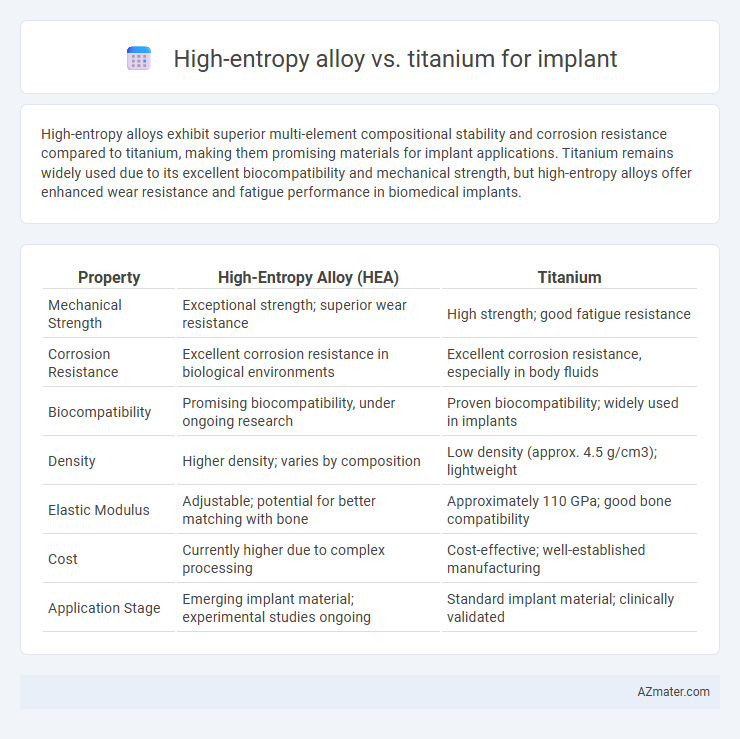High-entropy alloys exhibit superior multi-element compositional stability and corrosion resistance compared to titanium, making them promising materials for implant applications. Titanium remains widely used due to its excellent biocompatibility and mechanical strength, but high-entropy alloys offer enhanced wear resistance and fatigue performance in biomedical implants.
Table of Comparison
| Property | High-Entropy Alloy (HEA) | Titanium |
|---|---|---|
| Mechanical Strength | Exceptional strength; superior wear resistance | High strength; good fatigue resistance |
| Corrosion Resistance | Excellent corrosion resistance in biological environments | Excellent corrosion resistance, especially in body fluids |
| Biocompatibility | Promising biocompatibility, under ongoing research | Proven biocompatibility; widely used in implants |
| Density | Higher density; varies by composition | Low density (approx. 4.5 g/cm3); lightweight |
| Elastic Modulus | Adjustable; potential for better matching with bone | Approximately 110 GPa; good bone compatibility |
| Cost | Currently higher due to complex processing | Cost-effective; well-established manufacturing |
| Application Stage | Emerging implant material; experimental studies ongoing | Standard implant material; clinically validated |
Introduction to Implant Materials: High-Entropy Alloy vs Titanium
High-entropy alloys (HEAs) and titanium are prominent materials used in biomedical implants due to their exceptional mechanical properties and biocompatibility. Titanium alloys, especially Ti-6Al-4V, are widely favored for their corrosion resistance, lightweight nature, and ability to integrate with bone tissue. High-entropy alloys offer a novel approach with enhanced strength, wear resistance, and potential for tailored biocompatibility through multi-element compositions, positioning them as a promising alternative to traditional titanium-based implants.
Material Composition: High-Entropy Alloys Explained
High-entropy alloys (HEAs) consist of five or more principal elements mixed in near-equiatomic proportions, creating a complex, multi-element microstructure that offers superior mechanical strength and corrosion resistance compared to traditional titanium implants. Titanium, primarily composed of 90% titanium with small amounts of aluminum and vanadium, is valued for its biocompatibility and lower density but can lack the enhanced wear resistance and structural stability found in HEAs. The unique multicomponent composition of HEAs allows for tailored properties such as improved fracture toughness and oxidation resistance, making them a promising alternative for long-lasting orthopedic implants.
Titanium: Properties and Clinical Applications
Titanium exhibits exceptional biocompatibility, corrosion resistance, and a favorable strength-to-weight ratio, making it a preferred material in orthopedic and dental implants. Its osseointegration capabilities promote stable bone bonding, reducing implant rejection rates and enhancing long-term clinical outcomes. The alloy's low elastic modulus closely matches human bone, minimizing stress shielding and improving patient recovery.
Mechanical Strength: Comparing High-Entropy Alloys and Titanium
High-entropy alloys (HEAs) exhibit superior mechanical strength compared to titanium, with yield strengths often exceeding 1,000 MPa, while titanium alloys typically show yield strengths around 800-1,100 MPa. HEAs offer enhanced hardness and improved wear resistance due to their multi-element composition, which promotes solid-solution strengthening and nanoprecipitate formation. Titanium alloys provide excellent strength-to-weight ratios and good fatigue resistance but generally fall short of the ultra-high strength and tailored mechanical properties achievable with HEAs for implant applications.
Corrosion Resistance in Biomedical Environments
High-entropy alloys (HEAs) demonstrate superior corrosion resistance compared to titanium in biomedical environments due to their multi-element composition, which forms stable and protective oxide layers. Titanium exhibits excellent biocompatibility and corrosion resistance primarily from its passive TiO2 layer but is more susceptible to localized corrosion under aggressive physiological conditions. HEAs offer enhanced mechanical stability and corrosion resistance, making them promising candidates for long-term implant applications where ion release and degradation risks are critical concerns.
Biocompatibility and Osseointegration Performance
High-entropy alloys (HEAs) exhibit superior biocompatibility with reduced ion release and enhanced corrosion resistance compared to conventional titanium implants, minimizing inflammatory responses. The complex multi-element composition of HEAs promotes improved osseointegration by facilitating better bone bonding and faster new bone formation at the implant interface. Titanium remains a benchmark for implant materials due to its proven mechanical strength and well-documented osseointegration, but HEAs offer promising advancements in tailored surface chemistry and biostability that could surpass titanium's performance in future biomedical applications.
Longevity and Failure Rates: High-Entropy Alloy vs Titanium
High-entropy alloys (HEAs) demonstrate superior longevity in implants due to their enhanced mechanical strength, corrosion resistance, and biocompatibility compared to titanium. Studies report lower failure rates in HEA implants attributed to their resistance to fatigue and wear, reducing the need for revision surgeries. Titanium, while widely used, is more prone to stress shielding and fatigue-induced failures over extended periods, impacting implant durability.
Manufacturing Processes and Customization Potential
High-entropy alloys (HEAs) offer advanced manufacturing capabilities through additive manufacturing techniques like selective laser melting, enabling intricate designs and tailored microstructures for implants, surpassing the customization potential of titanium which relies mainly on conventional machining and limited additive processes. Titanium's well-established industrial processes ensure biocompatibility and mechanical reliability but face challenges in achieving complex geometries and gradient properties compared to HEAs. The versatile phase composition of HEAs allows for tunable mechanical and corrosion resistance properties, optimizing implant performance beyond the standard parameters achievable with titanium.
Cost-Effectiveness and Market Availability
High-entropy alloys (HEAs) offer improved mechanical properties and corrosion resistance compared to titanium, often at a lower material cost due to the use of more abundant metals. Titanium remains widely used in implants due to its established biocompatibility and extensive market availability, despite higher raw material and processing costs. The cost-effectiveness of HEAs is increasing as manufacturing techniques mature, but titanium currently dominates the implant market due to proven clinical performance and supply chain reliability.
Future Prospects and Research Directions in Implant Materials
High-entropy alloys (HEAs) offer promising future prospects in implant materials due to their exceptional mechanical properties, corrosion resistance, and biocompatibility, potentially surpassing traditional titanium implants. Ongoing research focuses on optimizing HEA compositions to enhance osseointegration, reduce ion release, and improve fatigue resistance under physiological conditions. Advanced computational modeling and additive manufacturing techniques are driving innovations to tailor HEAs for customized, long-lasting implants with superior performance compared to conventional titanium-based devices.

Infographic: High-entropy alloy vs Titanium for Implant
 azmater.com
azmater.com